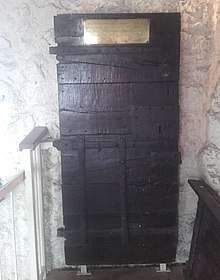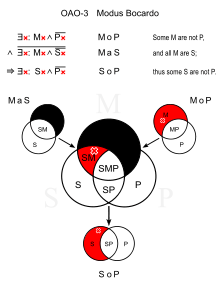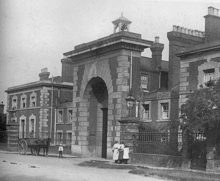Bocardo Prison
The Bocardo Prison in Oxford, England existed until 1771. Its origins were medieval, and its most famous prisoners were the Protestant Oxford martyrs (Thomas Cranmer, Hugh Latimer and Nicholas Ridley) in 1555.[1]

History
It was located near the church of St Michael at the North Gate; the prison consisted in fact of rooms in a watchtower by Oxford's North Gate, the tower being attributed to Robert D'Oyly, a Norman of the eleventh century,[2] though also said to be originally a Saxon construction of c.1000–50;[3] the gate itself was called also Bocardo Gate.[4] The rooms were over the gate, and there was a box in the church for charitable contributions to the prisoners.[5] John Powderham, who claimed to be the real king in the reign of Edward II of England, was imprisoned there in or shortly before 1318, prior to being hanged.[6] The prison was demolished in 1771, for a road construction scheme, following an Act of Parliament in 1770, and as part of the wider city redevelopment in Oxford under John Gwynn.[1][7]
Name

Bocardo is also a mnemonic for a traditional syllogism in scholastic logic. An example:
Some cats have no tails.
All cats are mammals.
Some mammals have no tails.
There is a folk etymology for the name: because Bocardo was found to be one of the harder forms of valid syllogism for students to learn, it was said to be the name of a prison that was hard to escape from. One of the rooms in Newgate Prison was also named bocardo.[8] An essay presented to the Oxford University Genealogical and Heraldic Society in 1835 suggested that the name was "derived from the Anglo-Saxon, bochord, a library or archive". It also says that it is "probable" that "the academic prison lent its name to logic".[9]
Notes
- "Oxford City Wall". Oxford History. Retrieved 11 January 2019.
- How, Frederick Douglas (1910). Oxford. Beautiful England. Blackie. Retrieved 11 January 2019 – via Project Gutenburg.
- Pevsner, Nikolaus; Sherwood, Jennifer (1974). The Buildings of England: Oxfordshire. Penguin. pp. 294–95. ISBN 0140710450.
- For example, in John Foxe's Acts and Monuments.
- "Archived copy". Archived from the original on 7 January 2010. Retrieved 20 February 2010.CS1 maint: archived copy as title (link)
- Oxford Dictionary of National Biography
- Stephen, Leslie; Lee, Sidney, eds. (1890). . Dictionary of National Biography. 23. London: Smith, Elder & Co – via Wikisource.
- Thomas, A H, ed. (1932). "Calendar – Roll A 25: 1381–83". Calendar of the Plea and Memoranda Rolls of the City of London. 3, 1381–1412. London. See footnote 50. Retrieved 11 January 2019 – via British History Online.
- Second Annual Report of the Proceedings of the Oxford University Genealogical and Heraldic Society. Volume 1. Oxford: J. Vincent. 1835. p. 37. Retrieved 11 January 2019 – via Google Books.
